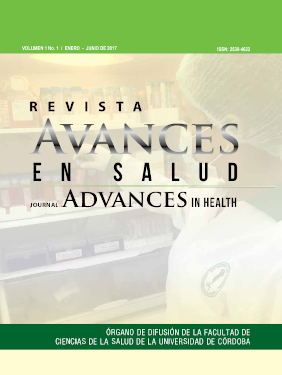Level of happiness in a group of elderly adults of Monteria, belonging to a dance program
Nivel de felicidad en un grupo de adultos mayores de montería, pertenecientes a un programa de danza.
Show authors biography
Objective. Describe the level of happiness of a group of older adults belonging to the project of solidarity extension of the University of Cordoba “Dancing for my health”. Materials and method. Research of a quantitative nature, the sample consisted of 36 longevity selected for convenience to whom the General Happiness Scale was applied. Results. The predominant gender was female with 91%, the age range ranged from 60-90 years, after a year of belonging to the program all without exception to a greater or lesser degree expressed to feel happy, the highest levels occurred in females, Nevertheless, in contrasting happiness level with having and being, this trend changes 86% showed low levels of happiness, stating that if they had less economic concerns they could be happier. Conclusions. The high perception of happiness evidenced could be related to the fact that the older adults performed for a prolonged period and in a stable physical activity (dance) and participated actively in a program of solidarity extension with educational, welfare and recreational interventions in which Had the opportunity to share frequently with their counterparts, corroborating once again the importance of dance as a main strategy and integrating axis, a fundamental element to increase the socializing capacity, welfare, self care, health and happiness in the elderly; Therefore, it is necessary to reorient and optimize the Public Policies for the health and well-being of the longevity, expanding their opportunities of inclusion to integral health programs.
Article visits 1825 | PDF visits
Downloads
- Martínez A D. Revista chilena de neuro- psiquiatría.versión On-line ISSN 0717- 9227.Rev.chil. neuro-psiquiatr. vol.54 no.1 Santiago mar. 2016. [consultado marzo 2016]. Disponible en: http:// www.scielo.cl/scielo.php?script=sci_ arttext&pid=S0717-92272016000100001
- Delgado J M. La Felicidad. Donde se siente y como se alcanza. Como cultivar y aumentar la felicidad personal. Ediciones Temas de Hoy. Madrid. 1988.
- Ruut V. El estudio de la satisfacción con la vida: Intervención Psicosocial, 1994, vol. 3, págs. 87-116 Vol. XLVII Nº 2 junio de
- Saez N A, et al. Cambio y socialización en la tercera edad, Investigaciones Psicológicas, 1993, Vol. 12: 129-152.
- Belando M M. Modelos sociológicos de la vejez y su repercusión en los medios, Reconstruyendo identidades. Una visión desde el ámbito educativo, Comunicación de Ciudadanía (2006).
- Moyano E E. Moscoso S. David Deporte, salud y calidad de vida. colección estudio sociales N. 26.
- Bohórquez M, et al. Felicidad y actividad física en personas mayores. Escritos de Psicología.
- Arcila M H. Medición de niveles de bienestar subjetivo o felicidad, de una muestra a conveniencia, de los afiliados al programa para la salud psicofísica –prosa–, universidad de Antioquia. Medellín, 2001.
- Garcia M M A. SUBJECTIVE WELL-BEING. Escritos de Psicología. Malaga, España 2002, 6: 18-39.
- Marrazzo B M. Mi cuerpo es mi lenguaje, expresión corporal de la danza. Buenos aires Argentina. Editorial Ciordia, 1975 p. 16-27 Dance.
- Myers GJ, Shack JR. Structural Convergence of Mood and Personality: Evidence of Old and New Directions. Journal of Personality and Social Psychology. Citado sep 20 2016, disponible en: http:// escritosdepsicologia.es/descargas/revistas/ num6/escritospsicologia6_analisis1.pdf.
- Vivaldi F, Barra E. Terapia Psicológica 2012, Vol. 30, N° 2, 23-29 Copyright 2012 by Sociedad Chilena de Psicología Clínica ISSN 0716-6184 (impresa) ISSN 0718- 4808
- Inga J, Vara A. Factores asociados a la satisfacción de vida de adultos mayores de 60 años en Lima- Perú. Univ. Psychol. Bogotá (Colombia) 5 (3): 475-485, octubre- diciembre de 2006. http://www.scielo.org. co/pdf/rups/v5n3/v5n3a04.pdf







